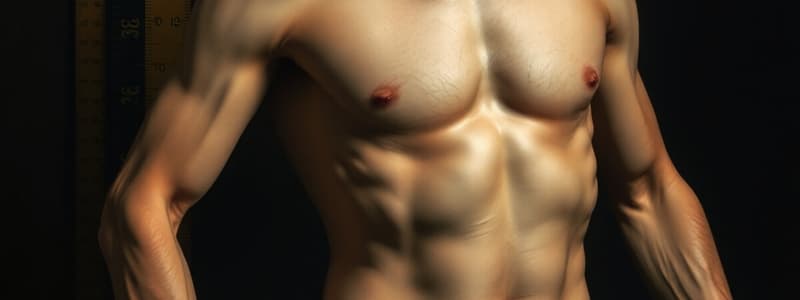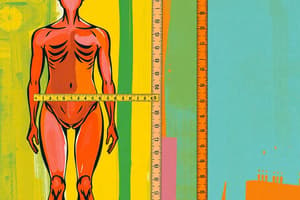Podcast
Questions and Answers
Which method uses total body water to estimate lean body mass?
Which method uses total body water to estimate lean body mass?
- Skinfold thickness measurement
- Bioelectrical impedance analysis (BIA) (correct)
- Dual-energy X-ray absorptiometry (DXA)
- Mid-upper-arm muscle area calculation
What is a limitation of using Body Mass Index (BMI) as a measure of nutritional status?
What is a limitation of using Body Mass Index (BMI) as a measure of nutritional status?
- It must be calculated using age and gender parameters.
- It does not differentiate between fat and lean mass. (correct)
- It is only applicable to males.
- It requires expensive equipment for measurement.
Waist circumference is primarily used to assess which aspect of body composition?
Waist circumference is primarily used to assess which aspect of body composition?
- Overall body weight
- Lean body mass
- Muscle strength
- Fat distribution (correct)
Which of the following best describes the use of skinfold thickness measurements?
Which of the following best describes the use of skinfold thickness measurements?
The mid-upper-arm muscle area (MUAMA) is calculated to assess which nutritional component?
The mid-upper-arm muscle area (MUAMA) is calculated to assess which nutritional component?
In a healthy adult male, what is the typical handgrip strength measurement in kilograms?
In a healthy adult male, what is the typical handgrip strength measurement in kilograms?
Which of the following anthropometric measures can indicate protein status?
Which of the following anthropometric measures can indicate protein status?
What does a decrease in handgrip strength in older adults typically indicate?
What does a decrease in handgrip strength in older adults typically indicate?
What is the SGA tool primarily used for in clinical settings?
What is the SGA tool primarily used for in clinical settings?
Which of the following tools focuses specifically on nutritional status and frailty?
Which of the following tools focuses specifically on nutritional status and frailty?
Among the following, which parameter is not considered a risk factor for malnutrition according to the MNA?
Among the following, which parameter is not considered a risk factor for malnutrition according to the MNA?
What is a common limitation of the MUST and NRS-2002 screening tools in identifying malnutrition risk in elderly patients?
What is a common limitation of the MUST and NRS-2002 screening tools in identifying malnutrition risk in elderly patients?
Which tool combines the predictive capacity of the MNA's full version with a shorter administration time?
Which tool combines the predictive capacity of the MNA's full version with a shorter administration time?
What is the primary advantage of using anthropometric measures in assessing nutritional status?
What is the primary advantage of using anthropometric measures in assessing nutritional status?
Which method is NOT typically considered a component of total body mass?
Which method is NOT typically considered a component of total body mass?
In body composition assessment, what type of information does waist and hip circumference provide?
In body composition assessment, what type of information does waist and hip circumference provide?
When measuring skinfold thickness, which area is typically NOT included in standard assessments?
When measuring skinfold thickness, which area is typically NOT included in standard assessments?
What does the Mid-Upper-Arm Muscle Area (MUAMA) primarily assess?
What does the Mid-Upper-Arm Muscle Area (MUAMA) primarily assess?
Which of the following is a limitation of using Body Mass Index (BMI) for assessing nutritional status?
Which of the following is a limitation of using Body Mass Index (BMI) for assessing nutritional status?
What is a novel marker in body composition assessment?
What is a novel marker in body composition assessment?
Which measurement is essential when calculating BMI?
Which measurement is essential when calculating BMI?
How can hydration status affect body weight measurements?
How can hydration status affect body weight measurements?
What limitation is associated with the use of skinfold thickness as a measure of body fat?
What limitation is associated with the use of skinfold thickness as a measure of body fat?
Which of the following is a strength associated with using Body Mass Index (BMI) in epidemiologic studies?
Which of the following is a strength associated with using Body Mass Index (BMI) in epidemiologic studies?
What does a Mid-Upper-Arm Muscle Area (MAMA) measurement assess?
What does a Mid-Upper-Arm Muscle Area (MAMA) measurement assess?
In the context of waist circumference measurements, which population is noted to have a higher percentage of body fat at lower BMI levels?
In the context of waist circumference measurements, which population is noted to have a higher percentage of body fat at lower BMI levels?
Which novel marker has been shown to best predict cardiometabolic abnormalities in a specific population?
Which novel marker has been shown to best predict cardiometabolic abnormalities in a specific population?
According to the 2002 WHO Expert Consultation, what BMI value is recognized as posing a high risk for type 2 diabetes and cardiovascular disease in Asian populations?
According to the 2002 WHO Expert Consultation, what BMI value is recognized as posing a high risk for type 2 diabetes and cardiovascular disease in Asian populations?
What is a limitation of anthropometric measurements concerning the time of day they are taken?
What is a limitation of anthropometric measurements concerning the time of day they are taken?
Which measurement technique is described as a valid measure for identifying central adiposity?
Which measurement technique is described as a valid measure for identifying central adiposity?
What is the implication of using calf circumference (CC) for assessing muscle mass and bone density?
What is the implication of using calf circumference (CC) for assessing muscle mass and bone density?
What is a significant strength of using skinfold thickness measurements in body composition assessment?
What is a significant strength of using skinfold thickness measurements in body composition assessment?
What is the primary reason for the downward bias in self-reported BMI measurements?
What is the primary reason for the downward bias in self-reported BMI measurements?
In the NHANES III study, how much lower was the mean self-reported BMI compared to the technician-measured BMI?
In the NHANES III study, how much lower was the mean self-reported BMI compared to the technician-measured BMI?
Which correlation value indicates the strongest relationship between self-reported and measured BMI values for whites, according to the data?
Which correlation value indicates the strongest relationship between self-reported and measured BMI values for whites, according to the data?
What effect does self-reported data have on calculating BMI for an individual with a weight of 50 kg and height of 1.65 m?
What effect does self-reported data have on calculating BMI for an individual with a weight of 50 kg and height of 1.65 m?
Which statement about the criteria for an ideal measure of body fatness is correct?
Which statement about the criteria for an ideal measure of body fatness is correct?
In terms of self-reported and measured BMI, which of the following health markers showed similar correlations?
In terms of self-reported and measured BMI, which of the following health markers showed similar correlations?
What systematic error is observed in the measurement of BMI using self-reported data?
What systematic error is observed in the measurement of BMI using self-reported data?
How does self-reported weight typically influence BMI calculations?
How does self-reported weight typically influence BMI calculations?
Which of these factors contributes to the accuracy of BMI as a measure of body fatness?
Which of these factors contributes to the accuracy of BMI as a measure of body fatness?
Study Notes
Anthropometric Measures
- Anthropometric measures are used to assess body composition and nutritional status.
- The most common measures include height, weight, waist circumference, hip circumference, skinfold thickness, mid-upper-arm circumference, and calf and thigh circumference.
- Anthropometric measures are inexpensive, easy to train, and non-invasive.
- However, they can be affected by time of day and location, and they are subjective in nature.
Muscle Mass
- Dual-energy X-ray absorptiometry (DXA) is a popular technique for assessing muscle mass.
- DXA is an accurate measure of muscle mass, but it requires specialized equipment and trained personnel.
- Bioelectrical impedance analysis (BIA) is another method that estimates lean body mass by measuring the body's electrical conductivity.
- BIA is less accurate than DXA, but it is cheaper, portable, and easier to use.
Muscle Strength
- Handgrip strength is a commonly used measure of muscle function.
- Typical handgrip strength in healthy males is approximately 40–50 kg, while females typically have a handgrip strength of 20–30 kg.
- Handgrip strength can vary between dominant and nondominant arms, and it tends to decrease with age.
- Muscle strength can be assessed using a dynamometer, a commercially available device.
Nutritional Status
- Anthropometric and body composition measures are used to assess nutritional status.
- They may be used to assess protein status, fat stores, body water, and other indicators related to nutritional status.
- Questionnaires can be used to assess nutritional status. Some examples of questionnaires include the NRS-2002, MUST, CONUT, MNA, SGA, PG-SGA, SNAQ, NRI, GNRI, and GLIM criteria.
- The Mini Nutritional Assessment (MNA) is a validated nutrition screening and assessment tool that can identify geriatric patients who are malnourished or at risk of malnutrition.
Body Mass Index (BMI)
- BMI is a measure of body fatness.
- It is a simple, cheap, and accessible measure that is highly correlated with body fat and health risks.
- BMI is a good predictor of long-term health, morbidity, and mortality in both adults and children.
- However, it does not take into account body composition, muscle mass, or bone density as factors in its calculation.
- BMI is associated with height in children and can vary between different ethnic groups.
- Lower BMI cut-points may be more appropriate for some Asian and Pacific populations than for other populations.
Waist Circumference
- Waist circumference is a valid measure of central adiposity, which is associated with an increased risk of cardiovascular disease and type 2 diabetes.
- However, waist circumference cut-offs and indices can vary among ethnic groups, as Asians tend to have a higher percentage of body fat at lower BMIs.
Skinfold Thickness
- Skinfold thickness is a measure of subcutaneous fat, which is assumed to make up approximately 50% of total body fat.
- This technique is inexpensive and easy to measure.
- However, it requires trained personnel to perform the measurement accurately.
- The distribution of subcutaneous fat varies across the body, so skinfold thickness can be a less accurate measure of total body fat.
Mid-Upper-Arm Muscle Area (MAMA)
- MAMA is a measure of overall muscle mass.
- It is determined from the mid-upper-arm circumference (MUAC) and triceps skinfold thickness (TSF).
- MAMA can be used to assess muscle status, which is classified based on the percentage of standard measurement.
- A percentage below 50 is classified as wasted, 60 is below average, 75 is average, 100 is adequate, and above 120 is high muscle.
Calf Circumference (CC) and Thigh Circumference (TC)
- CC and TC are measures of lower extremity muscle mass and bone density.
- They are recommended as alternatives to DXA due to the complexity and impracticality of DXA for assessing muscle mass.
- CC and TC better reflect body composition changes, including lower extremity muscle loss, which contributes to decreased mobility and an increased risk of falls.
- CC and TC are strongly correlated to muscle mass and are predictors of bone mineral density (BMD) and disability.
Novel Markers
- Novel markers such as abdominal volume index (AVI), waist-to-height ratio (WHtR), and waist circumference (WC) are better predictors of cardiometabolic abnormalities than traditional measures like BMI.
- These novel markers have been found to be more sensitive in detecting cardiometabolic abnormalities in a sample of Lebanese adults.
Studying That Suits You
Use AI to generate personalized quizzes and flashcards to suit your learning preferences.
Related Documents
Description
This quiz explores anthropometric measures used to assess body composition and nutritional status, including height, weight, and circumference measurements. It also covers methods for evaluating muscle mass and strength, such as DXA and bioelectrical impedance analysis, emphasizing their accuracy and practicality.




